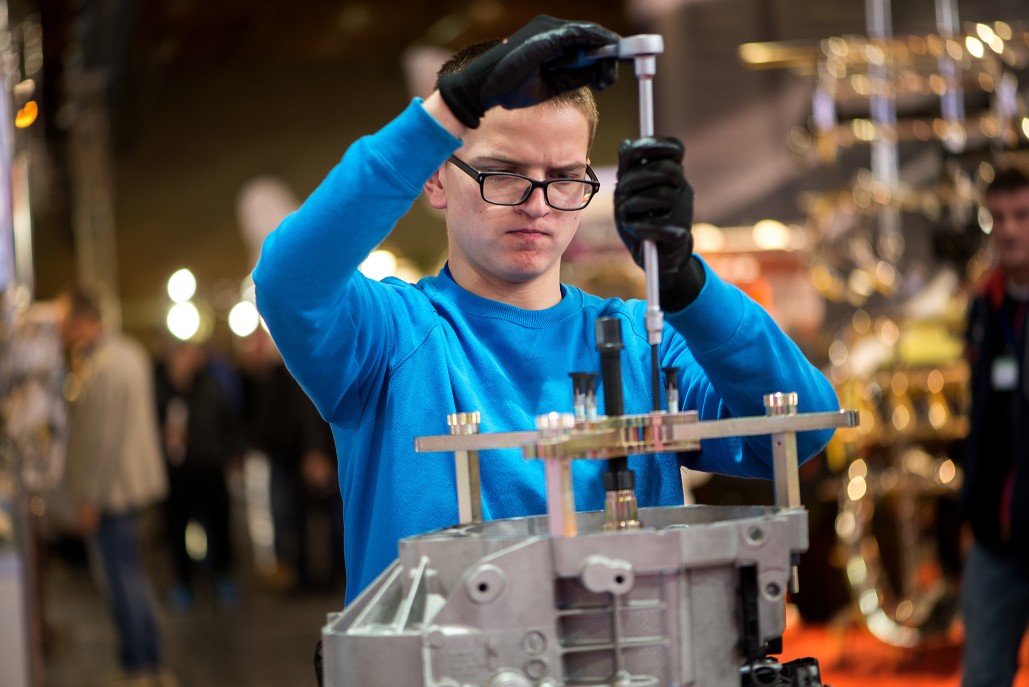Written by Sina Zhen
January 8, 2021
Known as the Motor City that birthed the automotive industry, Detroit is now establishing itself as the hub and global leader for mobility. As the mobility sector continues to evolve, one of the main challenges is to grow the talent pipeline and envision what skills are needed to bridge that talent gap. What better way to understand what future mobility needs are than to engage the future leaders of tomorrow and to start thinking about where the sector may lead? The Michigan Mobility Institute (MMI) is privileged to partner with two great organizations in the community to fill that talent gap.
Last summer, MMI was thrilled to have Brice Logan, a recent graduate from Ben Carson High School, as an intern through his placement from Growing Detroit’s Youth Talent (GDYT), an organization that provides summer jobs for Detroit’s youth. Brice has participated in the GDYT summer job program for three years and has had three summer internship experiences, including working at an elderly needs facility, a software company, and most recently, with MMI. Brice acknowledges GDYT for expanding his horizons on career opportunities.
GDYT was founded in 2014 under the leadership of Detroit Mayor Mike Duggan, and has provided approximately 5,000 jobs during its inception. It has expanded to providing over 8,000 jobs to Detroit’s youth in the past few years. These young people between the ages of 14 and 24 receive work readiness training, on-the-job experience, professional contacts, and exposure to potential career paths as part of GDYT. The program recruits a diverse group of young people with the only requirement being that they be a Detroit resident that is eligible to work in the United States.
More than half of the youth employed are between the ages of 14 and 16 where they have little to no work experience. GDYT introduces these youth to career opportunities through job shadowing in fields such as law enforcement, nursing, and accounting, among others. For youth with more work experience, such as Brice, the organization offers a platform with instructors lecturing about five industries including manufacturing, information technology, customer service, construction, and health care. This allows the youth to work directly with live instructors, engage with employer partners, and get valuable insight into a specific industry through virtual Q&A. Besides employing GDYT participants, MMI was also a contributor in ramping up the manufacturing module to include mobility and innovation training. Jessica Robinson, Co-founder and Chair of MMI, led the initiative to include innovation and technology topics, as well as provided instruction to some of the participating youth, informing them of what future jobs in the mobility sector may look like.
As the COVID-19 pandemic has caused many youth-employment organizations to cancel their programs, GDYT is continuing strong in moving their program virtually. “Detroit never considered canceling our program,” says Marie Hocker, Executive Director of GDYT. “This summer [in 2020], more than ever, young people need the income as parents have been laid off due to the pandemic.” Through generous external partners such as Denver Public Schools Community District (DPSCD) and other Detroit philanthropic organizations, GDYT was able to
provide technological access to youths in the program. Chromebooks were distributed to 60% of the youth, and each participant was granted three months of internet access and IT support. “It is important that we need to continue building their skillset, so they’re ready after this is over.”
Young people who participate in these programs are more likely to pursue higher education or transition into a full-time career with their previous employer. Brice is just one example of the many youth who have a clear vision for their future through his participation in the program. Speaking with Brice regarding his experience, he said that he has gained valuable skills in time management as well as an appreciation and understanding of the mobility industry and how important it is for society today. But the highlight of his internship was working with Dexter Sullivan, or Mr. Sullivan as Brice calls him, Program Manager for MMI. “Mr. Sullivan is a real mentor for me, not just professionally, but also on a personal level. He taught me many life skills,” says Brice. He also credits Sullivan for encouraging him to attend Wayne State University where he either plans on pursuing a degree in nursing or mechanical engineering. The latter piqued his interest due to his internship experience revolving around ideas to progress mobility in Detroit, such as what can be built in the city, how to make vehicles more efficient, and ideas addressing mobility equity in disadvantage neighborhoods.
GDYT currently has 174 partners that provide job opportunities, workforce training, and professional skillsets for youths. These partnerships are a win-win situation, Hocker states. “Not only does it help our youth build that skillset, but it also helps employers fill their talent pipeline, and serve their employment needs.”
The organization also recently launched a mentorship program that pairs 18 to 20 year olds with mentors. In its inaugural program which aimed for 50 mentors, GDYT had over 70 professionals signed up, indicating an interest from professionals to give back by offering their time in guiding tomorrow’s leaders.
Another organization that MMI was honored to partner with last year was SAE Detroit Section. SAE Detroit Section was established in 1911 and is the largest of the 46 sections of SAE International across the nation with 6,000 members locally with careers in engineering, aerospace, and automotive and commercial-vehicle industries. The section’s goals include: providing technical and networking events for its local members, hosting numerous outreach events that engage high school students towards automotive industry careers, and supporting SAE collegiate members as they transition into professional members.
The biggest value from the organization is the networking opportunity. “The pandemic has been a big challenge for us now as we’re not able to meet in person to network and connect,” says Renee´ Bovair, Executive Director of SAE Detroit Section. The organization was able to host over 15 virtual events last year including talks of various topics such as the Hype Cycle, IIHS crash test, cyber security, and drones, among others. “Another challenge of ours is to figure out our members’ needs, as technology is moving fast, we need to stay relevant by offering topical discussions in various areas that people find informative and valuable,” added Bovair.
MMI partnered with SAE Detroit Section last March to address the different phases that a professional may face throughout their career. SAE has strong programs that pair college students and older professionals. Their aim is to provide more support to young professionals who are entering the work force at a dynamic time with applicable education to today’s technology. “We want to help collegiate members see the value of being an SAE member, and support them from college all the way through their professional career. And we are constantly
looking at ways to engage this group,” Bovair stated. For their younger members, the section plays a central role in organizing the Young Automotive Professionals Conference (YAPC), collaborating with automotive manufacturers and industry leaders to speak to the attendees on the current challenges in the industry. To engage high school students, the section hosts a Micro-Electric Vehicle Competition where students build a mini-vehicle powered by one AA battery and compete with other schools for cash prizes. They also have a poster competition where students are encouraged to channel their creativity in imagining “tomorrow’s future in technology.” Scholarships are provided for the winners of the challenge. “We want to engage students to be interested in this field,” said Roxanne Loeffler, Senior Event Coordinator at SAE Detroit Section. For its collegiate members, the section provides support in a Formula SAE workshop as preparation for the SAE International competition. “We also offer two $20,000 scholarships for a child or grandchild of a SAE Detroit Section member to invest in our community,” added Loeffler.
Partnering with GDYT and SAE Detroit Section has inspired MMI to think about how the organization engages with younger audiences and the needs in the overall talent pipeline for the industry. As the mobility industry continues to evolve, we need to hear from the younger generation on what their needs are and how they envision the future of this industry. We also need to focus our work on providing the support for their transition from academia to the professional world. However, as the old proverb goes, “If you want to go fast, go alone. If you want to go far, go together.” Partnerships and collaboration are key. “It takes partnership to move everyone’s goals forward. We all bring our own piece and help collectively figure out what the strategy might be,” states Jessica Robinson. Renee´ Bovair agrees by adding that, “Working together is so much easier than working alone in a silo.” In working together, these organizations have been able to reach a wider audience in terms of raising awareness to their priorities and introducing their members and partners to a wider network of resources. MMI looks forward to another great year of continued work with these two wonderful organizations along with their other partners in advancing the talent pipeline in Detroit.





